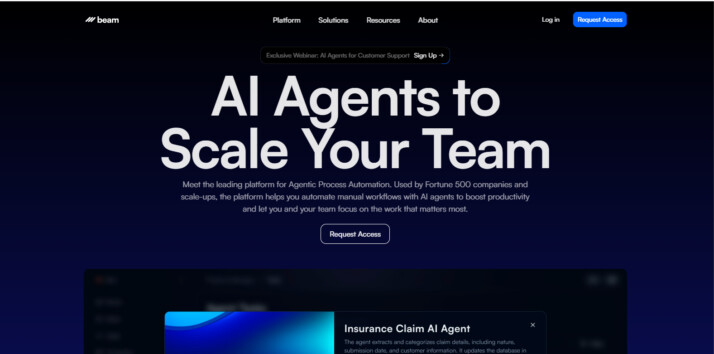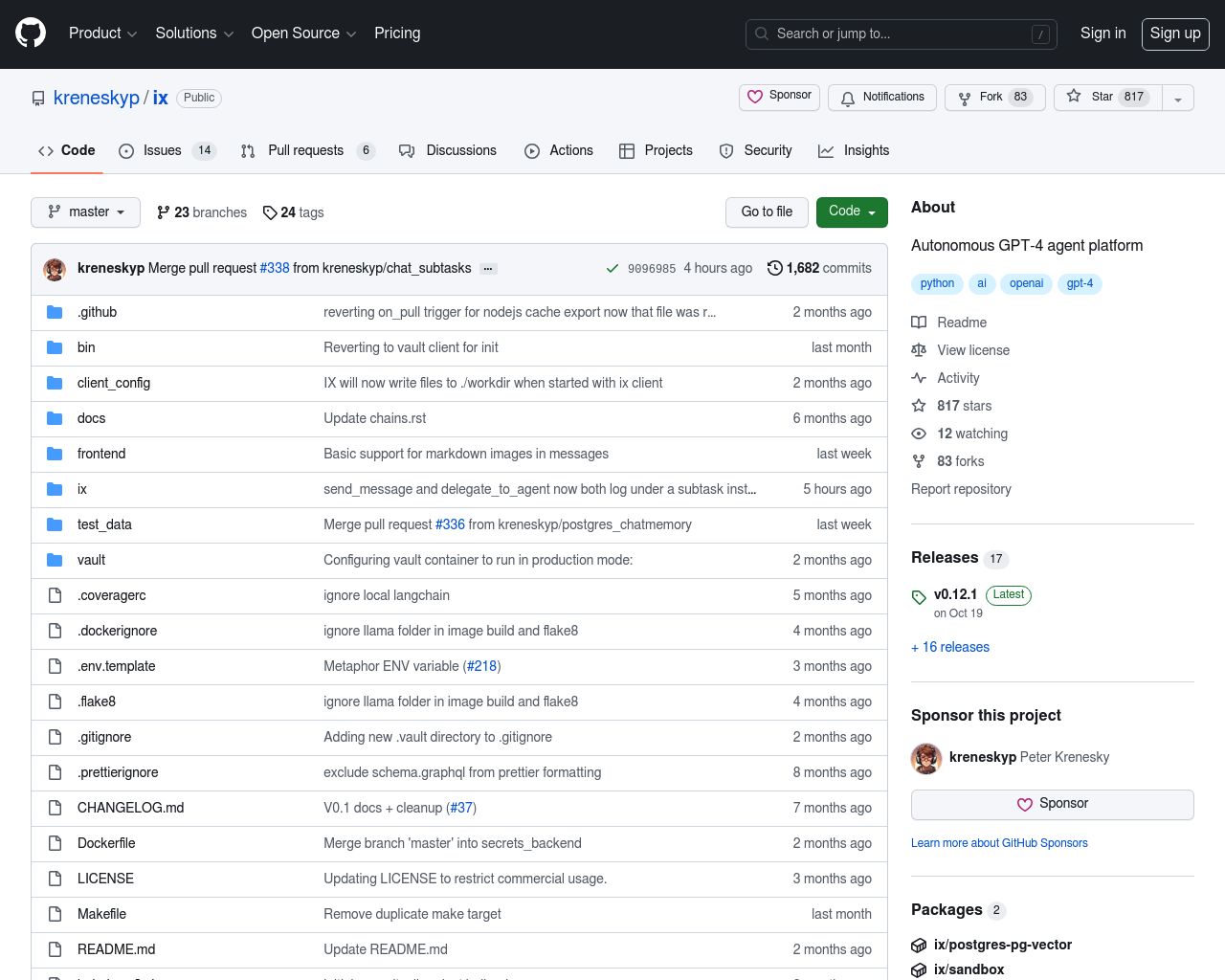Beam AI vs. Agent IX: Comparing Enterprise and Open-Source AI Platforms
AI agents are transforming how businesses automate tasks and boost productivity. This comparison explores Beam AI vs. Agent IX, two platforms at the forefront of AI agent development. Beam AI specializes in enterprise-grade automations, while Agent IX offers an open-source approach for developers. We’ll examine their key features, strengths, and limitations to help you determine which solution best fits your organization’s needs. We’ll also introduce SmythOS, a versatile alternative that combines powerful capabilities with user-friendly design. Whether you’re a developer seeking customization or a business leader looking for scalable AI solutions, this guide will equip you with the insights to make an informed decision in the rapidly evolving world of AI automation.
Beam AI Overview
Beam AI specializes in creating generative AI agents for automating repetitive tasks and enhancing productivity in organizations. Beam AI focuses on Agentic Process Automations (APA), which perform tasks faster and more cost-effectively than humans. These agents continuously learn and adapt, improving precision and efficiency over time.
The platform targets key areas such as back-office automation, customer service, compliance, and order processing. Beam AI’s agents integrate with existing internal systems to plan and execute workflows, providing comprehensive automation solutions. The company emphasizes sustainability, aiming to minimize steps and reduce human carbon footprints in achieving organizational goals.


Beam AI specializes in creating generative AI agents for automating repetitive tasks and enhancing productivity in organizations.
Beam AI’s agents feature advanced conversational interfaces for seamless interaction and efficient task management. The platform supports multi-agent collaboration, allowing multiple AI agents to work together on complex tasks. This capability enhances problem-solving and enables the handling of intricate workflows across various business processes.
While Beam AI offers robust features for AI agent deployment and management, it lacks some tools that could enhance user experience. The platform does not provide a visual builder or no-code editor, which might limit accessibility for non-technical users. Additionally, there’s no mention of a dedicated debug mode or multimodal capabilities, potentially constraining the range of data types the agents can process.
Agent IX Overview
Agent IX is an open-source platform that empowers developers to create, host, and manage autonomous AI agents. These agents leverage advanced language models to perform complex tasks, collaborate, and adapt to various scenarios.


Agent IX stands out with its support for multiple agents running in parallel, facilitating seamless collaboration and knowledge sharing. The platform features a no-code agent editor, allowing users to create and test agents without programming skills. Its smart input bar enhances efficiency by auto-completing task-related entries.
Agent IX stands out with its support for multiple agents running in parallel, facilitating seamless collaboration and knowledge sharing.
Built for horizontal scalability, Agent IX utilizes a message queue-driven backend to support numerous agents operating simultaneously. It integrates with various AI models, including OpenAI, Google PaLM, Anthropic, and Llama, offering flexibility in model selection. The platform’s extensibility allows for the creation of custom agents and chains, making it highly adaptable to specific user requirements.
While Agent IX offers powerful features, it may present challenges for users seeking a more guided experience or extensive pre-built templates. The open-source nature of the platform means users might need to invest time in understanding its architecture and customization options. Additionally, the level of community support and documentation may vary compared to some commercial alternatives.
Agent IX integrates with existing tools and systems through its flexible API and webhook deployment options. This enables seamless incorporation into various workflows and applications. However, users should consider their specific integration needs and evaluate the platform’s compatibility with their existing tech stack.
Feature Comparison
Beam AI and Agent IX offer distinct approaches to AI agent development, with notable differences in their core components and security features. Beam AI provides a robust platform for creating generative AI agents focused on automating repetitive tasks and enhancing productivity. Its strengths lie in autonomous agent capabilities, multi-agent collaboration, and integration with existing systems. However, Beam AI lacks a visual builder and no-code editor, potentially limiting accessibility for non-technical users.
Agent IX, as an open-source platform, emphasizes flexibility and customization. It supports multiple agents running in parallel and offers a no-code agent editor, making it more accessible to users without programming skills. Agent IX’s extensibility allows for creating custom agents and chains, adapting to specific requirements. However, it may present challenges for users seeking extensive pre-built templates or a more guided experience.
In terms of security, both platforms prioritize data protection, but their approaches differ. Beam AI emphasizes data encryption and IP control features, crucial for enterprise-level deployments. Agent IX, being open-source, relies more on community-driven security practices and may require additional configuration for robust enterprise-grade security. This distinction highlights the trade-off between the commercial, enterprise-focused approach of Beam AI and the open, customizable nature of Agent IX.
Feature Comparison Table
| Beam AI | Agent IX | SmythOS | |
|---|---|---|---|
| CORE FEATURES | |||
| Visual Builder | ❌ | ✅ | ✅ |
| No-Code Options | ❌ | ✅ | ✅ |
| Memory & Context | ✅ | ❌ | ✅ |
| Explainability & Transparency | ✅ | ❌ | ✅ |
| Debug Tools | ❌ | ✅ | ✅ |
| Multimodal | ❌ | ✅ | ✅ |
| Audit Logs for Analytics | ✅ | ❌ | ✅ |
| SECURITY | |||
| Constrained Alignment | ✅ | ❌ | ✅ |
| COMPONENTS | |||
| Data Lakes | ❌ | ❌ | ✅ |
| DEPLOYMENT OPTIONS (EMBODIMENTS) | |||
| Staging Domains | ✅ | ❌ | ✅ |
| Deploy as Scheduled Agent | ✅ | ❌ | ✅ |
| DATA LAKE SUPPORT | |||
| Hosted Vector Database | ❌ | ✅ | ✅ |
| Sitemap Crawler | ❌ | ❌ | ✅ |
| YouTube Transcript Crawler | ❌ | ❌ | ✅ |
| URL Crawler | ❌ | ✅ | ✅ |
Best Alternative to Beam AI and Agent IX
SmythOS emerges as the superior alternative to Beam AI and Agent IX, offering a comprehensive AI agent development platform that combines ease of use with powerful features. Our drag-and-drop interface revolutionizes agent creation, making it accessible to users of all skill levels. Unlike Beam AI’s lack of visual tools, SmythOS empowers users to build complex AI workflows without extensive coding knowledge.
We provide unparalleled flexibility in deployment options, allowing users to integrate AI agents seamlessly into existing systems. SmythOS supports deployment as APIs, webhooks, site chats, and scheduled agents, surpassing the limited options offered by Agent IX. This versatility enables businesses to tailor AI solutions to their specific needs across various use cases.
SmythOS excels in scalability and performance, critical factors for enterprise-level deployments. Our platform handles large-scale operations efficiently, supporting multiple agents working collaboratively.
SmythOS excels in scalability and performance, critical factors for enterprise-level deployments. Our platform handles large-scale operations efficiently, supporting multiple agents working collaboratively. This capability, combined with our robust security features including data encryption and OAuth support, positions SmythOS as the ideal choice for organizations seeking reliable and secure AI solutions.
Our commitment to continuous innovation sets us apart. SmythOS offers cutting-edge features like multimodal interactions, advanced problem-solving capabilities, and seamless integration with various AI models and APIs. These capabilities enable users to create sophisticated AI agents that can handle complex tasks across different data types and sources, a level of versatility not matched by Beam AI or Agent IX.
By choosing SmythOS, users access a future-proof platform that evolves with the rapidly changing AI landscape. Our comprehensive feature set, user-friendly interface, and unmatched flexibility make SmythOS the best alternative for those seeking to harness the full potential of AI agent technology.
Conclusion
Beam AI and Agent IX each offer unique approaches to AI agent development, catering to different user needs. Beam AI excels in enterprise-level automation with its focus on Agentic Process Automations, while Agent IX provides an open-source platform with flexibility for customization. However, SmythOS emerges as the superior choice, combining the best of both worlds and offering additional advantages.
SmythOS stands out with its intuitive drag-and-drop interface, extensive integration ecosystem, and versatile deployment options. Unlike Beam AI’s lack of a visual builder, SmythOS empowers users of all technical backgrounds to create complex AI workflows effortlessly. The platform’s support for multi-agent collaboration and diverse AI models surpasses Agent IX’s capabilities, offering a more comprehensive solution for businesses.
We’ve designed SmythOS to revolutionize AI implementation, making it 99% faster and more accessible. Our platform’s ability to deploy agents across various environments, from APIs to chatbots, coupled with robust security features and scalability, positions it as the ideal choice for businesses seeking to harness AI’s full potential. To experience the future of AI automation and unlock unprecedented efficiency gains, create a free SmythOS account today. Discover how our 300,000+ seamless integrations can transform your workflow and drive innovation in your industry.
Last updated:
Disclaimer: The information presented in this article is for general informational purposes only and is provided as is. While we strive to keep the content up-to-date and accurate, we make no representations or warranties of any kind, express or implied, about the completeness, accuracy, reliability, suitability, or availability of the information contained in this article.
Any reliance you place on such information is strictly at your own risk. We reserve the right to make additions, deletions, or modifications to the contents of this article at any time without prior notice.
In no event will we be liable for any loss or damage including without limitation, indirect or consequential loss or damage, or any loss or damage whatsoever arising from loss of data, profits, or any other loss not specified herein arising out of, or in connection with, the use of this article.
Despite our best efforts, this article may contain oversights, errors, or omissions. If you notice any inaccuracies or have concerns about the content, please report them through our content feedback form. Your input helps us maintain the quality and reliability of our information.
